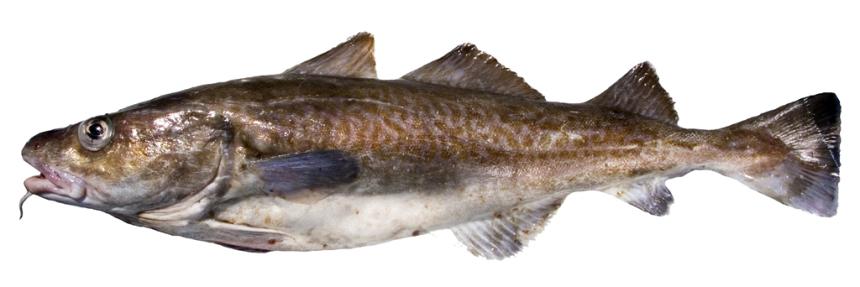High
Commonly caught off the Washington coast by commercial harvesters using otter-trawls and longline gear. Recreational harvest within Puget Sound is now closed, with the exception of restricted fishing in the San Juan Islands and Strait of Juan de Fuca.
Description and Range
Physical description
The body of the Pacific cod is elongate and ranges in color from brown to grey on the dorsal side. It has brown spots or pale areas on the back and sides, and is lighter on the bottom.
The Pacific cod can grow up to 114 centimeters (3.7 feet) in length, weigh up to 22.7 kilograms (50 pounds), and live up to 13 years.
This species has a square caudal fin, three dorsal fins, and two anal fins. The first anal fin begins below the front of the second dorsal fin. The fins are somewhat dusky in color and usually white-edged. A distinguishing characteristic of this cod is the single chin barbell with a length about equal to the eye diameter.
Geographic range
Pacific cod range from Japan to the Bering Sea and to Santa Monica, California, but are rare south of northern California. They are widely distributed in the cooler regions of the Pacific and adjacent seas. Pacific cod are usually found near the bottom at water depths of 12 to 549 meters (40 to 1,800 feet). During the spring they are usually found in shallower waters than in the fall.
Climate vulnerability
Sensitivity to climate change
High
Though limited information is available regarding the sensitivity of the Salish Sea population of Pacific cod to climate change, their main sensitivity will be due to potential increases in sea surface temperature. Pacific cod spawning and recruitment are strongly linked to temperature, with colder water supporting larger hatch size and maximizing growth performance. Cooler waters also support higher abundance of zooplankton prey (e.g., copepods), which is thought to be linked to increased recruitment. Temperature over 7°C appear to be associated with poor spawning success and limited recruitment. For Atlantic cod, declines in recruitment with increasing temperature were particularly high for cod at the limits of their distribution. Pacific cod in Washington are already at the upper end of their thermal preference, which is likely to increase their sensitivity to any increases in temperature and could lead to northward population shifts.
Exposure to climate change
Moderate-
High
- Increased ocean temperatures
State record
- Weight
- 19.63 lbs
- Angler
- Ralph Bay
- Location
- Ediz Hook, Clallam County
- Date Caught
- March 6, 1984
